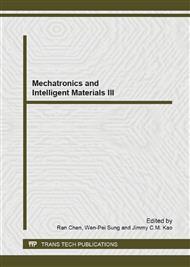p.654
p.658
p.663
p.667
p.674
p.678
p.682
p.687
p.691
Biped Walking Robot Gait Planning Research
Abstract:
This paper uses biped walking robot as the research object, and designs robots original system, based on the requirements of Biped Walking Robot Competition of China. According to the biped walking robots characteristics of multi-joints, many degrees of freedom, multivariable, strong coupling and nonlinearity [, we can build system model using the Denavi - Hartenberg coordinate, describe the system model by the homogeneous coordinate transformation theory, and then plan on system gait based on ZMP stability . Finally, we can solve for the joint trajectory of the system by using computer-aided software.
Info:
Periodical:
Pages:
674-677
Citation:
Online since:
June 2013
Authors:
Price:
Сopyright:
© 2013 Trans Tech Publications Ltd. All Rights Reserved
Share:
Citation:


